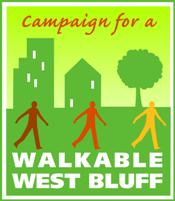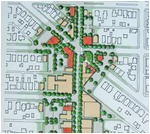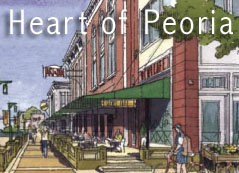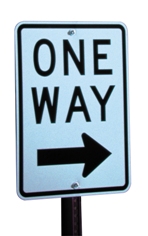 Sometimes, like when the City Council is trying to shut down the Heart of Peoria Commission, you start to wonder if residents are still interested in the Heart of Peoria Plan, walkable neighborhoods, pedestrian-friendly streetscapes, and other facets of New Urbanism.
Sometimes, like when the City Council is trying to shut down the Heart of Peoria Commission, you start to wonder if residents are still interested in the Heart of Peoria Plan, walkable neighborhoods, pedestrian-friendly streetscapes, and other facets of New Urbanism.
That’s why I was so excited to hear about this grassroots effort by West Bluff residents to create a Campaign for a Walkable West Bluff. They will be meeting tonight (March 18) at 6:30 p.m. in Bradley Hall, Room 142, if you’re interested in getting involved.
Here’s an article that was published in my neighborhood newsletter, written by those organizing this new campaign. It explains a little bit more about what they hope to achieve:
A group of neighbors and business owners in the West Bluff community are initiating a Campaign for a Walkable West Bluff, which we see as an effort to embrace “New Urbanism” as it pertains to quality of life in our neighborhoods. New Urbanism promotes walkable, neighborhood-based development as an alternative to sprawl. It is highlighted in DPZ’s Heart of Peoria (HOP) plan.
We believe that by creating a vibrant Main Street Corridor, we can also spur new mixed-use development, encourage the refurbishment of existing properties and even slow the speed of cars traveling through our neighborhoods. Improving our commercial district will potentially increase our property values, increase owner occupancy of our homes and help combat the perception that the West Bluff is unsafe.
We have met with Councilwoman Barbara Van Auken and she is enthusiastic about the possibilities such a partnership among neighbors presents. As our campaign takes shape, our intent is to collaborate with existing initiatives (West Bluff Council, Renaissance Park and Heart of Peoria Commissions) and events (Grand Tour of Homes, Moss Avenue Sale) to build community-wide support and make change happen. We may even organize a few walking, bus riding and biking events ourselves!
We are taking our cue in part from an excellent book we have discovered titled “The Great Neighborhood Book: A Do-it Yourself Guide to Placemaking” by Jay Walljasper, Senior Fellow at Project for Public Spaces (www.pps.org). This book is full of ideas for improving neighborhoods from communities across the country and the world. The recurring theme in this book is that ordinary people getting together and having fun is the best way to generate ideas and find solutions to common problems.
Our next meeting is set for March 18, 2008 at 6:30 pm in Bradley Hall, Room 142. We invite you to join us. We are interested in meeting with neighbors to answer questions and gather input.
“Long experience has shown us that bottom-up strategies work better than top-down approaches. The bottom-up strategy recognizes citizens as the experts, is guided by the wisdom of the community, and builds a strong partnership between the public and private sectors.” –Jay Walljasper, “The Great Neighborhood Book: A Do-it Yourself Guide to Placemaking.”
This campaign has also been profiled in the Journal Star and the Bradley Scout.

 A public meeting was held Wednesday night at Columbia Middle School to talk about streetscape and intersection improvements in the Sheridan-Loucks Triangle form-based code area. It’s a small stretch of Sheridan road, bounded by the south side of Hanssler on the north, and the north side of McClure on the south.
A public meeting was held Wednesday night at Columbia Middle School to talk about streetscape and intersection improvements in the Sheridan-Loucks Triangle form-based code area. It’s a small stretch of Sheridan road, bounded by the south side of Hanssler on the north, and the north side of McClure on the south. Although the Heart of Peoria Commission is currently slated to receive no funding in the city’s proposed 2008 capital budget, that doesn’t mean the Heart of Peoria area is getting no funding for projects.
Although the Heart of Peoria Commission is currently slated to receive no funding in the city’s proposed 2008 capital budget, that doesn’t mean the Heart of Peoria area is getting no funding for projects. 
 The city council on Tuesday tacitly approved
The city council on Tuesday tacitly approved  I meant to post this awhile ago and just never got around to it. One of the things the Heart of Peoria Commission is focusing on these days is fixing the streets. That doesn’t just mean filling potholes. It means making the streets more balanced thoroughfares — streets that comfortably accommodate not just cars, but also pedestrians, bicycles, and mass transit.
I meant to post this awhile ago and just never got around to it. One of the things the Heart of Peoria Commission is focusing on these days is fixing the streets. That doesn’t just mean filling potholes. It means making the streets more balanced thoroughfares — streets that comfortably accommodate not just cars, but also pedestrians, bicycles, and mass transit.